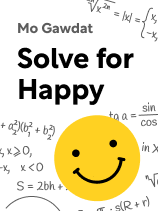

This article is an excerpt from the Shortform book guide to "Solve for Happy" by Mo Gawdat. Shortform has the world's best summaries and analyses of books you should be reading.
Like this article? Sign up for a free trial here.
Is fear good? Does it serve a positive purpose? If not, how can you get rid of fear?
According to Mo Gawdat, fear is useless and just gets in the way of your happiness. In his book Solve for Happy, he recommends confronting your fear and dispelling it by asking seven questions that expose it as an unworthy intrusion in your life.
Read more to learn Gawdat’s argument and his advice on how to confront your fear.
Is Fear Good?
Is fear good? Some believe that fear serves a positive purpose in our lives. However, Gawdat sees it differently. He explains that our obsession with control stems from a fear of the unknown. This fear itself is part of a deeply ingrained misconception that fear protects us from harm. Against this misconception, Gawdat argues that fear is useless because it leaves us paralyzed and doesn’t lead us to actions needed for happiness. To dispel this misconception, we have to confront our deepest fears head-on.
(Shortform note: Against Gawdat’s claim that fear is useless, some experts maintain that fear is beneficial in moderation. At a basic level, fear indicates potential dangers; consequently, those who are without fear due to brain disorders can stumble into dangerous experiences. At a deeper level, fear can provide the motivation needed to make helpful changes to our lives.)
However, we often don’t know our deepest fears because core fears—like rejection—are masked by layers of derivative fears—like a fear of first dates. Gawdat calls this our “safe model,” where our brain protects us from a core fear via layers of derivative fears. For example, if your core fear is rejection, your safe model might include a fear of embarrassment, leading to a fear of vulnerability, and so on. (Shortform note: Gawdat’s description of a safe model suggests that it may precede avoidance coping, a defense mechanism that causes people to consciously or subconsciously change their behavior to avoid anxiety-inducing issues—for instance, through procrastination.)
How to Confront Your Fear
Because the fears implemented by our safe model are wide-reaching, Gawdat argues that they negatively shape our expectations, causing us to expect harm at every turn. Accordingly, to bring our expectations in line with reality, we must face our fear. Here’s how to confront your fear, according to Gawdat.
Ask yourself the following seven questions:
- “What’s the worst-case scenario?” Asking this leads you to acknowledge what you’re most afraid of.
- “Who cares if that happens?” Asking this shows that even the worst-case scenario isn’t the end of the world.
- “Is it likely that will happen?” Asking this shows that the worst-case scenario is unlikely.
- “How do I prevent the worst from happening?” Asking this provides concrete steps to avoid the worst-case scenario.
- “Can I rebound if the worst does happen?” Asking this helps reveal that, if the worst case does occur, you’ll be alright.
- “What if I don’t face my fears?” Asking this reveals that doing nothing is often worse than facing your fears.
- “What’s the best that could happen?” Asking this emphasizes the potential benefits of facing your fears.
By asking yourself these seven questions, you’ll be prepared to face your fears and recognize the misconception that fear is on your side.
(Shortform note: To supplement Gawdat’s list, many experts recommend exposure therapy, where you expose yourself to your fears in incrementally larger doses. For those with crippling fears, this might first require imagined exposure. For instance, if you’re afraid of heights, you might imagine looking out from the top of a skyscraper. Eventually, you’ll progress to facing your fears concretely in controlled environments.)

———End of Preview———
Like what you just read? Read the rest of the world's best book summary and analysis of Mo Gawdat's "Solve for Happy" at Shortform.
Here's what you'll find in our full Solve for Happy summary:
- The six misconceptions that cause us to suffer
- How to remove the seven weaknesses that hinder your happiness
- The five pillars to becoming permanently happy






